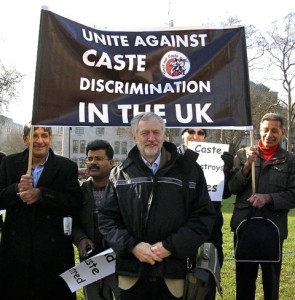Sanjeev Kumar
In contemporary world, you find broadly two models of development. One is the Bhagwati Model which suggests unconditional encouragement of new investment in the economy. According to this model, the revenue generated from these new investments for states could be used for the improvement of living standards of the downtrodden sections of society. The newly generated revenue can rapidly increase state’s expenditure on people welfare programs. This model refuses to encourage enough state’s expenditure on public welfare programs because according to them if the state give more importance to expenditure which would discourage new investment i.e. expenditure on infrastructure development, incentives for new investment etc. It is this model which the Gujarat Government is following since the last decade.
In contrast to this model, there is another model, suggested by economists like Amartya Sen, which give more importance to state’s investment in public welfare programs such as education, health etc. The Sen model posits that human capital is the most precious resource for any economy. This model, it is claimed, is followed partly by states like MP and Bihar. It is in this backdrop that I would like the reader to read this report. If I have to summarise this entire report in one sentence, I would say that Gujarat’s model of development is “pornification of the neo-liberal model of development”. Gujarat’s model is nothing but a “pornified form of Indian model of development”.
In the neo-liberal world, investment is considered as equal to development. Despite launching ambitious projects like Vibrant Gujarat in order to attract foreign direct investment, Gujarat could not attract enough FDI. In 2011-12 Gujarat ranks 5th in foreign direct investment (FDI) but by the 2012-13 it slips to 6th position. (dnaindia, 12 April 2013) (The Hindu, 12 April 2013) ( First Post, 15 April 2013) According to the latest report of Reserve Bank of India, the position of Gujarat in per capita FDI is eighth in India. Out of the total Foreign Direct Investment in India, the share of Gujarat is only 3.1%. FDI in Gujarat was 28,000 crore during 2000 to 2010 while MH topped the list with 1.75 lakh crore, followed by Delhi at 1.02 lakh crore, and Karnataka.
A report of the World Bank on “The Investment Climate in 16 Indian States” reveals that in terms of Investment Climate Index (ICI) the position of Gujarat among 16 major Indian states is third. Investment through a state led project called ‘Vibrant Gujarat’ about which there was a huge hype has also been proved a complete failure. Following are the promised and actual investments done under Vibrant Gujarat project in different years: (Frontline, 8 march 2013, ‘Mirage of development‘)
This Vibrant Gujarat movement of the Gujarat government to attract FDI in the state has been given unconditional hype by all kinds of media, the advertising agency APCO worldwide (the same agency is managing the election campaign of BJP in the 2014 Lok Sabha elections) and officials of the Gujarat government. But till now the total actual investment under this program in Gujarat was not more than 10 per cent of what has been promised.
In terms of Industrial Investment Proposals Gujarat stands in third position. Whatever investment that has been done in Gujarat was primarily in industrial and manufacturing sector while sectors such as agriculture, services etc were being relatively ignored. In terms of total investment Maharashtra’s input is not more than 9% of Gujarat’s inputs but in terms of output it is almost 20% higher than Gujarat’s.
In the name of encouraging investment, the kind of corporate loot of public property that Gujarat state not only allowed but facilitated to every extent cannot be matched by any other state. The best example of corporate loot in the State is the Tata Nano project which was given a loan worth around Rs 10,000 crore at 0.1% of interest rate for 20 years while the total cost of the project is not more than Rs 2,300 crore. The BOOT (Build Own Operate Transfer) policy initiative for port development involves royalty holidays instead of revenue sharing, permission to investors to adjust royalty against capital costs, freedom to developers to collect charges and tolls, land acquisition for private investors, 30 year window to make profits, special arrangements of forward linkages to private consortiums and SIRs and so on.
The CAG criticized Gujarat government for its imprudent fiscal management and asked for greater professionalism and accountability in the functioning of government. CAG said that Gujarat has incurred 41% higher debt than in the previous fiscal and burdened the exchequer with heavy interest liability at a higher rate. CAG said that state government had taken a loan of Rs 15,083 crore to adjust the monetary deficit of Rs 11,027 crore, leaving a balance of 3,645 crore which is poor debt management. Gujarat has invested Rs 39,179 crore in corporations, boards, government companies, rural banks and joint ventures. In the last five years, the average return on this investment was 0.25% while the state government has paid interest at the rate of 7.75%. CAG also criticised the government for not furnishing utilization certificate of Rs 9066.34 crore. (Economic Times: ‘8 holes CAG picked in Narendra Modi’s Gujarat development plan’)
The share of Industry in GDP increased in Gujarat during 2004-05 to 2009-10 but its contribution to employment generation decreased. During 2001-2008 the employment growth in Mining and Quarrying sector was -2.4%; in construction it was -2.8%; in Transport, Storage and Communication it was -2.9%. Gujarat ranks first in terms of direct industrial licenses issued but ranks seventh in employment; TN ranks seventh in investment in IEMs (Industrial Entrepreneur Memorandum) but ranks first in its share of creating employment from this investment. The contribution of Gujarat’s manufacturing sector in generating employment remained stagnant while the share of Gujarat’s manufacturing sector in India’s total manufacturing increased rapidly. On the other hand, TN did well in this aspect with a balanced growth of both employment and production.
This clearly indicates that Gujarat government prefers Capital Intensive Investments against Labour Intensive Investments. The capital intensive investments give priority to increasing value addition against increasing total employment generation. As expected in a capital intensive economic system, the investment in Gujarat is well ahead of a number of other states, but employment generation from those investments is worst in comparison with the amount of investment. The state ignored labour intensive investment. Gujarat accounts 5% of India’s population, 7% of India’s GDP, 14% of India’s manufacturing gross value added, 18.6% of fixed capital, 10% of total number of factories but only 9% of employment. During 2006-10, Gujarat signed MoUs worth Rs 5.35 lakh crore with potential of 6.47 lakh jobs. But Maharashtra and TN with Rs 4.20 lakh crore and Rs 1.63 lakh crore worth MoUs respectively, expect about 8.63 lakh and 13.09 lakh jobs. Tamil Nadu has 20% more population than Gujarat but gives employment to 77.5% more people than Gujarat. But in terms of gross value added Gujarat is 50% ahead of Tamil Nadu even though Gujarat’s input is much higher than Tamil Nadu. Gujarat’s rank in this term is 15th.
Textiles is one of the best employment generating industries but recent Gujarat policy ignored this sector. In 2010, the investment in textile industry was only 1.54% of the total investment while it generates 10.89% of total employment. Till 1990s investment in textile industry was around 10%. On the other hand investment in infrastructure sector constitutes 37.59% of total investment and its share in employment generation is only 21%. Thus Gujarat shifted from employment intensive model of investment to capital intensive model of investment.
This is part of a report on Gujarat’s model of development, written by me for Jagriti Natya Manch. I am the script writer, director and founding member of the Manch. This theatre group consists of students from JNU, DU and IIMC
~~~
Sanjeev Kumar (Antim)
(Subaltern1987@gmail.com )
JNU, Delhi.









